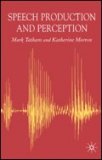|
Katherine Morton and Mark Tatham |
|||||
|
|
SYNOPSIS [download excerpt - more excerpts on the Palgrave website] This book is about models of speech production and perception. We outline several proposals for modelling production and perception made by researchers who address the questions: "what do speakers do" and the corollary "what do listeners do". The book draws together researchers' work spanning initial observations of 'sounds', their classification, experimental evidence supporting sound system descriptions, and suggestions for dynamic models in both production and perception of speech. Our proposed model, within the framework of the Chomskyan generative grammar approach, is presented. INTRODUCTION The first step for researchers is to state how the observation of speech sounds can be classified into various descriptive systems and the second stage is to model how an intended sound is achieved. The third stage is to propose dynamic models of production and perception: these are discussed with reference to the biological systems that move articulators and change the vocal tract configuration to produce intended sounds. Experimental work based on hypotheses from these models is presented. A model approach is taken to prosodics in which larger units overarching segments are generally grouped into syllables. Some formal linguistic work outlining prosodics is presented, along with experimental work modelling a link between prosodic features and groups of segments: i.e. intonation and syllables. Emphasis is placed on the difference between static models, which describe, and dynamic modelling, which attempts to show how the basic linguistic and phonetics can be related in an actual human speaker/listener. Since the listener forms part of the communication system, we address some of the descriptions of speech which initially drew on general models of perception built in the decades approximately 1930 - 1950. During that period, speech perception of segments and prosodic features were modelled within particular linguistic and phonetics traditions. Later in the 1960's, linguistic phonetics (and linguistics itself) developed into new theory based studies. Both static and dynamic models are addressed as to their differences and usefulness for various purposes. The interrelation between experimental work and theory building is presented by looking at three areas of speech research which both contribute to linguistic phonetics and which also benefit from findings in speech research: they are neuroscience (includes language pathology), language teaching, language engineering. Difficulties in cross disciplinary contributions and feedback are discussed; some innovative experimental design and results from those experiments are described. THE GOAL The purpose of the book is to pull together some strands in speech production and perception research which have apparently diverged, although we don't think that they have diverged in particularly major ways. In addition, it is seen as timely that attention be drawn to the benefits which emerge when applying the models developed in speech research to other disciplines and fields that deal with speaking and listening individuals, although researchers in these fields may not be working within paradigms derived from the more recent work by linguistic phonetics researchers.
|
||||
|
|
|||||
